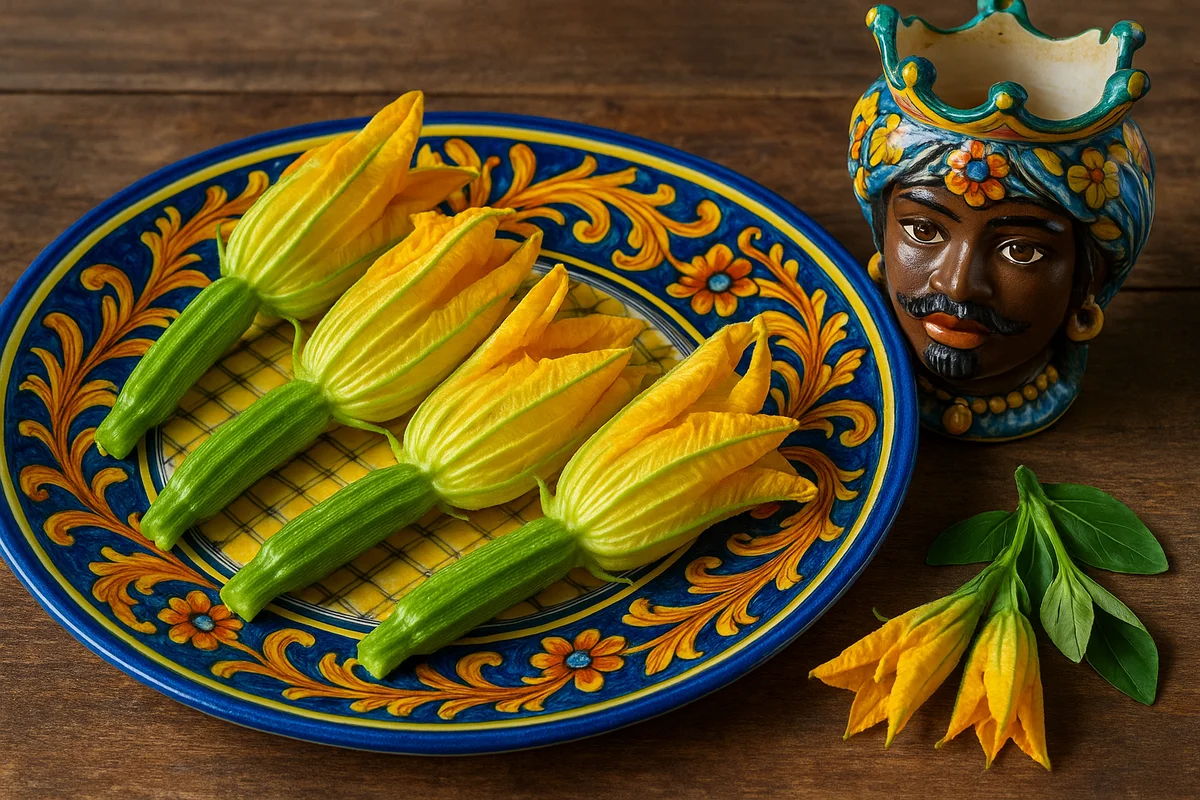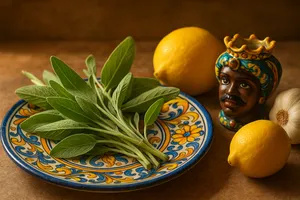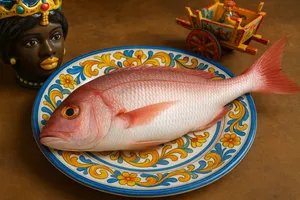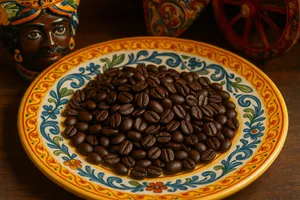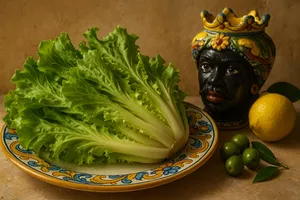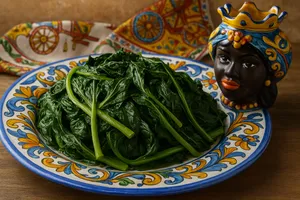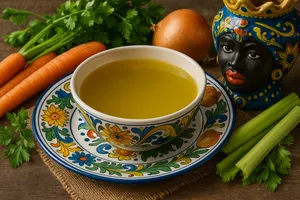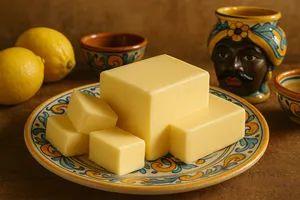Overview
Courgette flowers, known in Sicilian as “sciùri di cucùzza”, are the edible blossoms of pumpkin and courgette plants (Cucurbita), a delicate and treasured ingredient of the Sicilian summer kitchen. These flowers, with their intense yellow-orange colour and trumpet-like shape, are a seasonal delicacy much appreciated for simple yet refined preparations that enhance their gentle flavour and soft texture.
In Sicilian culinary tradition, courgette flowers are used mainly battered and fried, stuffed with ricotta or other cheeses, or added to omelettes and soups. Their limited seasonality and the delicate nature that demands immediate consumption after picking make them a special ingredient, eagerly awaited during the summer months when Sicilian gardens produce them in abundance.
Characteristics
Courgette flowers have an elongated trumpet shape, ranging in size from 8 to 15 centimetres depending on the variety. Their colour is a vivid yellow-orange, with delicate, silky petals. Inside the flower is the pistil (in female flowers) or the stamens (in male flowers), which must be removed before cooking as they are bitter.
The texture is soft and delicate, almost velvety. The flavour is sweet and gentle, vegetal and faintly floral, with notes reminiscent of courgette but finer and more refined. The aroma is subtle, fresh and distinctive.
Male flowers grow on long, thin stems and are more numerous. Female flowers, recognisable by the small fruit at the base (a miniature courgette), are fewer and often left on the plant to produce fruit. In cooking, male flowers are used predominantly.
Difference between male and female flowers
Male flowers grow on long, slender stems, are more numerous and have dusty yellow stamens inside. These are the flowers most often harvested for culinary use as picking them does not affect fruit production.
Female flowers are identified by the small swelling at the base (the ovary that will become the courgette) and contain a pistil. These flowers produce the fruit, so they are harvested only when abundant or when the plant’s production needs regulating.
There is no significant difference in flavour in cooking, but female flowers with the attached courgette are appreciated for certain stuffed preparations.
Harvesting and seasonality
In Sicily, courgette flowers are available from late spring to autumn, with peak production between June and August. Harvesting takes place early in the morning, when the flowers are fully open and at their freshest. The flowers close during the hottest hours, so morning harvesting ensures perfect blossoms.
They must be picked gently, detaching them at the base of the stem, and used as soon as possible as they are extremely perishable. Each courgette plant produces numerous male flowers which, if not collected, wilt after a day.
Culinary use
In Sicilian cuisine, courgette flowers are prepared in various traditional ways.
Fried courgette flowers
The most classic preparation involves whole, cleaned and dried flowers dipped in a light batter (flour, water, salt, sometimes egg) and fried in hot oil until golden. Crisp outside and soft within, they are an irresistible starter or side dish.
Stuffed and fried flowers
The flowers are filled with fresh ricotta, mozzarella, anchovies or a mixture of cheeses, then gently closed, dipped in batter and fried. The warm, melting filling contrasts with the crisp batter.
Courgette flower omelette
Flowers cut into strips are added to beaten eggs to make rustic, fragrant omelettes. Onion, mint or basil may be added to enrich the flavour.
Pasta with courgette flowers
Flowers cut into strips are sautéed with garlic and oil, then used to dress pasta, often alongside diced courgettes. Parmesan or pecorino is added.
Baked flowers
Stuffed flowers are arranged in a baking dish, drizzled with oil and baked until golden. This is a lighter alternative to frying.
Soups
Coarsely chopped flowers can be added to vegetable soups in the final minutes of cooking, giving a delicate flavour and decorative appearance.
Preparation
To prepare courgette flowers, proceed gently as they are extremely fragile. Gently open the flower and remove the internal pistil or stamens, which are bitter. Also remove the green calyx at the base of the flower if it is tough.
Check the inside of the flower for insects (ants or small spiders often seek refuge inside) and shake them out gently. Clean the flowers with a damp cloth rather than washing them under running water, as they are very delicate and would be damaged. If necessary, rinse them quickly under cold water and dry them immediately and gently.
For stuffed flowers, open the blossom, remove pistil/stamens, insert the filling with a teaspoon, then close the petals gently, twisting the tips slightly.
Batter for frying
The traditional Sicilian batter for courgette flowers consists of flour, cold sparkling water, a pinch of salt and sometimes an egg. The consistency should be fluid but not too liquid, so it coats the flowers without weighing them down.
Some recipes use only flour and water, others add beer for a lighter, crisper batter. The oil temperature must be high (170–180°C) to achieve a crisp, non-greasy fry. Flowers should be fried a few at a time to avoid lowering the oil temperature.
Storage
Courgette flowers are extremely perishable and should be used as soon as possible, ideally on the day of harvesting. They keep in the refrigerator for up to one day, placed gently in a container lined with damp kitchen paper.
They should never be washed before storage, only before use. They do not freeze well as they lose their texture entirely. They are an ingredient that must be enjoyed fresh to appreciate their qualities.
Fried flowers can be kept for a few hours at room temperature, but should be eaten fresh as they quickly lose crispness.
Buying tips
When buying courgette flowers, choose blossoms that are fully open, bright yellow-orange, with firm petals free from dark spots or wilted areas. Avoid flowers that are closed, soft, darkened or whose petals detach easily.
The flowers should have a fresh, vegetal aroma. If they smell unpleasant or are slimy, they are no longer fresh. Check for insects inside. Favour flowers harvested the same morning or at most the day before.
Even better, if you have a garden or know someone who grows courgettes, pick the flowers in the morning and use them straight away for maximum freshness and quality.
Nutritional properties
Courgette flowers are very light: 100 grams provide about 12–15 calories. They are over 90% water and have very low levels of carbohydrates, proteins and fats.
They contain vitamins, particularly vitamin A (carotenoids responsible for the yellow-orange colour), vitamin C and some B vitamins. They are a source of minerals such as potassium, phosphorus and calcium, though their direct nutritional contribution is modest due to the small amounts used.
They have antioxidant properties thanks to carotenoids. They are easily digestible and suitable for all. Naturally, frying in batter significantly increases the calorie content of the final dish.
Courgette flowers in Sicilian gardens
In Sicily, pumpkins and courgettes have traditionally been grown in home gardens. The plants are vigorous and productive, offering both fruit and abundant flowers. Harvesting male flowers does not compromise fruit production; in fact, it helps regulate it.
It was traditional in farming families to pick the flowers in the morning and prepare them for lunch, fried or in omelette. It was a way to use everything the garden offered, avoiding waste and turning even the blossoms into a delicacy.
Curiosities
Courgette flowers have been eaten since antiquity. Pre-Columbian peoples of Central and South America, where pumpkins originated, used both the fruit and the flowers. With the arrival of the pumpkin in Europe after the discovery of the Americas, culinary use of the flowers spread throughout the Mediterranean.
In Sicily, courgette flowers were regarded as a “gift from the garden”, a delicate and special ingredient that housewives prepared with care for special occasions or to surprise guests. Their fleeting availability made them even more prized.
In rural tradition, the flowers were offered to neighbours and friends as a gesture of kindness when the garden was abundant. Receiving a bunch of fresh courgette flowers was a sign of esteem and friendship.
Besides pumpkins and courgettes, other cucurbits such as the Sicilian long gourd also produce edible flowers equally delicious. Each variety has blossoms slightly different in size but all suitable for the same uses.
In some Sicilian convents, nuns prepared stuffed courgette flowers in elaborate ways, with ricotta scented with herbs, creating refined dishes served during religious festivals or sold through the convent “wheels” to noble families.

